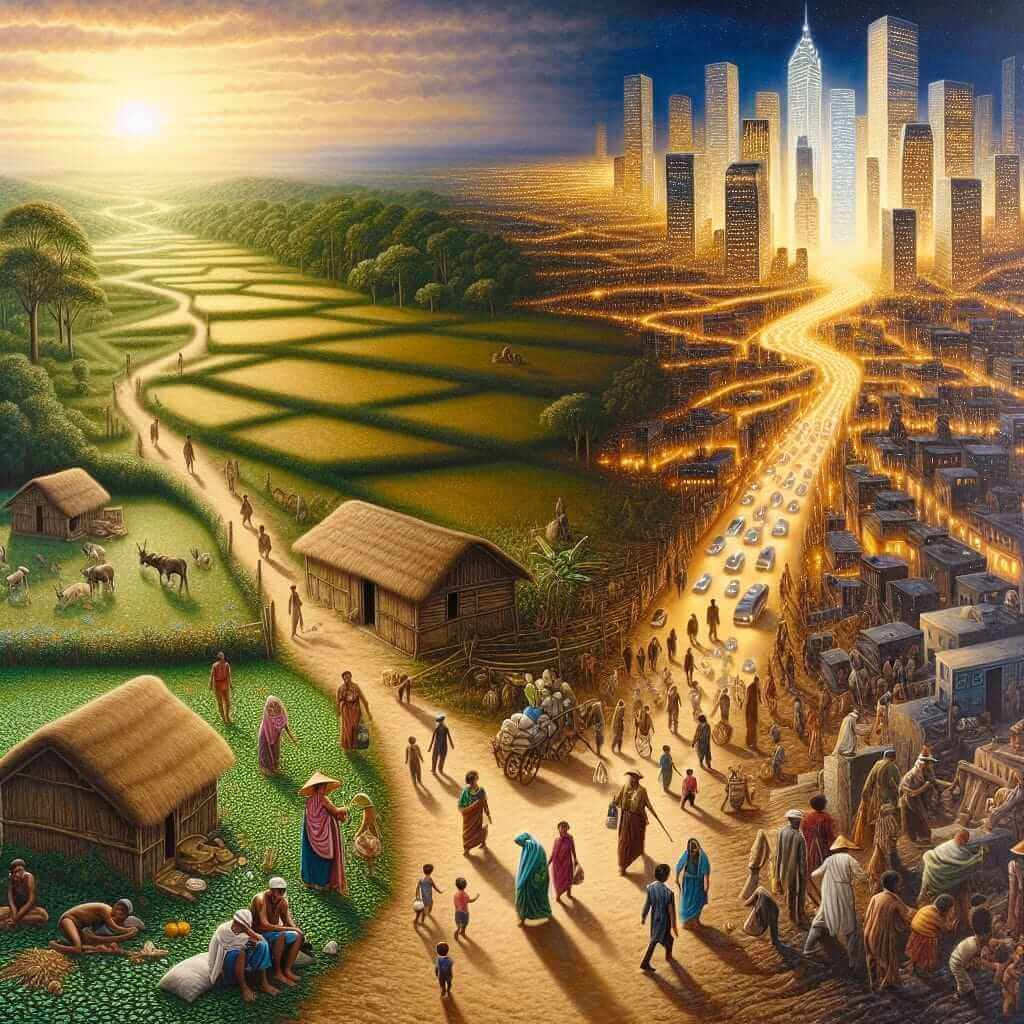“Rural to urban migration” is a prominent topic in IELTS Writing Task 2, reflecting global urbanization trends. This essay will delve into this issue, providing valuable insights and strategies for crafting a high-scoring IELTS essay. It will analyze common queries, present a sample essay question, provide a model answer, and offer essential vocabulary and writing tips.
Several websites illustrate the prevalence of this topic in past IELTS exams, indicating a high likelihood of encountering similar themes in future tests. Here are some examples of “rural to urban migration” essay questions:
- “In many countries, people are increasingly moving from rural areas to cities. What are the causes of this trend, and what are its consequences?”
- “Urbanization is a growing global phenomenon. Discuss the advantages and disadvantages of this trend for individuals and society.”
- “Do the advantages of urban living outweigh the disadvantages for young people in developing countries?”
Sample Essay Question
For this exercise, we will focus on the first question:
<blockquote><strong>”In many countries, people are increasingly moving from rural areas to cities. What are the causes of this trend, and what are its consequences?” </strong></blockquote>
Analysis
This question requires a balanced analysis of the causes and consequences of rural-urban migration. It is crucial to address both aspects of the question, exploring the motivating factors behind this migration pattern and its subsequent impacts on individuals and society.
Model Essay
<blockquote> In a world increasingly characterized by urbanization, the movement of people from rural areas to cities has become a defining trend. This essay will delve into the primary causes of this migration pattern and examine its multifaceted consequences.
One of the most significant drivers of rural-urban migration is the pursuit of economic opportunities. Cities are often perceived as centers of industry and commerce, offering a greater range of employment possibilities and higher wages. The allure of better-paying jobs and improved living standards acts as a powerful magnet, drawing individuals away from rural areas with limited economic prospects. Furthermore, access to education and healthcare facilities is often concentrated in urban centers, making cities more attractive to families seeking better opportunities for their children.
However, the influx of people into cities can strain infrastructure and resources. Rapid urbanization often outpaces the development of housing, transportation, and sanitation systems, leading to overcrowding, traffic congestion, and environmental degradation. The competition for jobs, housing, and essential services can also lead to social tensions and inequality within urban areas. Moreover, the depopulation of rural communities can result in the decline of agriculture and traditional industries, further exacerbating the economic disparities between urban and rural areas.
In conclusion, while the quest for economic advancement and improved living standards remains the primary impetus behind rural-urban migration, it is crucial to acknowledge the potential consequences of this trend. Addressing these challenges requires comprehensive urban planning initiatives that prioritize sustainable development, equitable resource allocation, and the revitalization of rural communities. By fostering a more balanced approach to urbanization, we can mitigate the negative impacts of this global phenomenon and create more equitable and sustainable societies.
</blockquote>
Word count: 270 words
Writing Tips
- Structure: Use a clear and logical structure, such as the one demonstrated in the model essay (Introduction, Causes, Consequences, Conclusion).
- Vocabulary: Use a range of vocabulary related to urbanization, migration, and their impacts. Avoid repetition and aim for precision in word choice.
- Grammar: Ensure grammatical accuracy, paying attention to subject-verb agreement, tense consistency, and correct punctuation.
- Coherence and Cohesion: Use linking words and phrases (e.g., “furthermore,” “however,” “in conclusion”) to create a smooth flow of ideas and connect paragraphs effectively.
Vocabulary
- Urbanization (n.) /ˌɜːrbənɪˈzeɪʃən/ : The process of becoming more like a city.
- Rural (adj.) /ˈrʊrəl/ : Relating to the countryside rather than the town.
- Migration (n.) /maɪˈɡreɪʃən/ : Movement from one place to another, especially to live or work.
- Infrastructure (n.) /ˈɪnfrəstrʌktʃər/ : The basic systems and services, such as transport and power supplies, that a country or organization uses in order to work effectively.
- Overcrowding (n.) /ˌoʊvərˈkraʊdɪŋ/ : The state of being filled with too many people or things.
- Congestion (n.) /kənˈdʒestʃən/ : The state of being crowded and full of traffic.
- Environmental degradation (n.): /ɪnˌvaɪrənˈmentl ˌdeɡrəˈdeɪʃən/ The process or fact of the environment becoming worse.
- Inequality (n.) /ˌɪnɪˈkwɒləti/ : The unfair situation in society when some people have more opportunities, money, etc. than other people.
- Depopulation (n.) /ˌdiːˌpɒpjʊˈleɪʃən/ : The reduction of the number of people living in a place.
- Revitalization (n.) /riːˌvaɪtəlaɪˈzeɪʃən/ : The process of making something stronger, more active, or more healthy.
Conclusion
Understanding the complexities of “rural to urban migration” is crucial for IELTS Writing Task 2. By reviewing model answers, analyzing vocabulary, and practicing writing techniques, you can approach this topic confidently. Remember to present a well-structured argument, use relevant vocabulary, and support your ideas with examples.

For further exploration of related urban topics, consider reading: